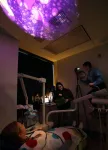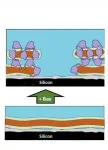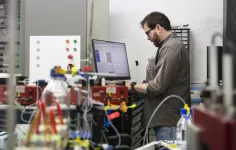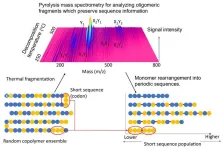(Press-News.org) New results from a study led by USC researchers at Children’s Hospital Los Angeles show that a sensory adapted dental clinic environment creates less distressing oral care experiences for autistic children. The open-access article is available today in JAMA Network Open.
“We’ve shown that the combination of curated visual, auditory and tactile adaptations — all of which are easily implemented, relatively inexpensive and don’t require training to safely use — led to statistically significant decreases in autistic children’s behavioral and physiological distress during dental cleanings,” said lead author Leah Stein Duker, assistant professor at the USC Chan Division of Occupational Science and Occupational Therapy.
Compared to typically developing peers, autistic children experience greater oral health care challenges, which are often associated with heightened responses to sensory input. The dentist’s office is filled with potentially overwhelming stimuli such as bright fluorescent lighting, whirring electric hand tools and reclining chairs. Stein Duker and the Sensory Adapted Dental Environments (SADE) research team, including colleagues from the Ostrow School of Dentistry of USC, are identifying and testing innovative approaches that can help alleviate those challenges in order to increase access and efficacy of oral care.
In this study, autistic children received cleanings in both a standard clinic environment and an adapted one. In the adapted setting, the dentist wore a surgical loupe with attached lamp, blackout curtains were hung over the windows and a slow-motion visual effect was projected onto the ceiling (children could choose between a “Finding Nemo” underwater scene or lava lamp-style abstract colors). A portable speaker played calming nature sounds and quiet piano music. A traditional lead X-ray bib placed on the child’s chest and a “butterfly” wrap secured around the dental chair provided deep pressure hugging sensation from shoulder to ankle, which has been shown to calm the nervous system.
Electrodes placed on the child’s fingers measured electrodermal activity, a physiological correlate of sympathetic nervous system activation akin to the fight-or-flight response. The researchers also observed the frequency and duration of distressed behaviors exhibited by the child during the cleaning, such as jerking away from the dentist, clamping down with the jaw, intentionally trying to bite the dentist or keep tools out of the mouth, crying and screaming.
The researchers did not find any differences in the quality of care provided in the adapted environment, compared to the regular environment. They also did not find any significant differences in the amount of time required to get the child seated and ready for the cleaning, demonstrating that adaptations do not create logistical hurdles.
“So many interventions try to change the person” Stein Duker said. “Instead, this intervention sees children for who they are — it does not try to fix or change them — focusing the intervention to modify problematic environmental factors as a way to empower the child and family to engage successfully in occupation.”
Adaptations can make all the difference
This publication is the latest from the SADE research project, led by Principal Investigator Professor Sharon Cermak, which dates back to 2011. Since then, the SADE intervention has been replicated in pilot studies with a number of different populations in several countries. However, Stein Duker said, this study is the first with a large enough sample size to attain full statistical power.
“Because it’s a fully-powered study, we were able to identify some other very exciting findings,” Stein Duker said. “For example, our data showed that children’s physiological stress dropped as soon as they entered the adapted dental cleaning room before the actual cleaning even began, and that level of physiological stress predicted behavioral distress during the cleaning.”
The researchers also identified factors predicting the intervention’s success for any given participant: younger age and lower IQ and/or lower expressive communication level were each associated with a proportionally greater reduction in participants’ stress.
“My daughter cannot even hear the word ‘dentist,’” said one participant’s parent. “But after being in the [SADE] room for a bit, she was able to have her teeth looked at for the first time in over a year.”
In addition to oral care disparities experienced specifically by autistic children, the study may also help close an ethnic disparity gap, as 72 percent of parents of the children enrolled self-identified as Hispanic. (Note: the term “Hispanic” is used in the US to refer to people who identify as Hispanic, Latino, Chicano, Latinx, Latine, etc., which appears to be a preferred pan-ethnic term among those who expressed a preference). Data has shown that Hispanic children in the US have oral health disparities: 52 percent of Hispanic youth ages 2-19 years have dental caries (cavities), which is the highest population prevalence compared to non-Hispanic Black (44 percent), Asian (43 percent) and White (39 percent) youth. Bilingual members of the SADE research team ensured fidelity with Spanish-speaking participants and families.
Stein Duker and her Tailored Environmental Modifications lab will next study the effectiveness of a modified SADE for typically developing children with dental fear and anxiety, a major challenge in pediatric dentistry experienced by approximately 20 percent of all US children. In the near future, she is also planning to collect preliminary data studying adolescents and adults with intellectual developmental disabilities and/or autism, populations she gets frequently asked about at dental conferences and research meetings.
“Regardless of population, my advice to dental professionals and parents alike is to work together to find ways to improve the overall clinic experience,” Stein Duker says. “There are weighted X-ray bibs in every single dental office that may help calm the child; they can wear sunglasses; they can wear a beanie hat covering the ears to muffle noises — all of these are completely free and easy adaptations that have the potential to improve the clinic experience for those with sensory sensitivities, without negatively impacting dentists’ ability to provide care.”
END
Sensory adapted dental rooms significantly reduce autistic children’s physiological and behavioral stress during teeth cleanings
Results of USC–CHLA study of 162 autistic children show that safe and feasible adaptations to the clinic environment created more relaxed, less anxious dental care experiences.
2023-06-02
ELSE PRESS RELEASES FROM THIS DATE:
Couples’ social networks took long-lasting hit during COVID
2023-06-02
Key takeaways:
A UCLA study shows that a the outset of the COVID-19 pandemic, social interactions, both virtual and in person, declined significantly for married couples.
The decline was found to be greater and more long-lasting for Black and Latino couples and lower-income couples than for white couples and wealthier couples.
The researchers suggest exploring new ways of protecting public health during crises that also help more vulnerable populations sustain meaningful relationships.
Following the lockdowns and restrictions on public gatherings in the early days of COVID-19, the social networks of white, ...
AI software can provide ‘roadmap’ for biological discoveries
2023-06-02
Predicting a protein’s location within a cell can help researchers unlock a plethora of biological information that’s critical for developing future scientific discoveries related to drug development and treating diseases like epilepsy. That’s because proteins are the body’s “workhorses,” largely responsible for most cellular functions.
Recently, Dong Xu, Curators Distinguished Professor in the Department of Electrical Engineering and Computer Science at the University of Missouri, and colleagues updated their protein localization prediction model, MULocDeep, ...
Study helps explain what drives psoriasis severity and offers clues as to how disease may spread to other body parts
2023-06-02
Beneath and beyond the reddish, flaky lesions that form in the skin of those with psoriasis, mild and severe forms of the disease can be told apart by the activity of key cells and signaling pathways, a new study shows.
Led by researchers at NYU Grossman School of Medicine, the study mapped hidden features of inflammation and how they compared in cases of increasing severity of psoriatic disease. The team’s findings may help explain how small areas of skin inflammation can have wide-ranging effects in other parts of the body. Up to one-fifth of those with the skin disease, the researchers note, ...
New study finds strengthening protection of existing parks is crucial for biodiversity conservation
2023-06-02
-With pictures-
In a new study, bioscientists argue that strengthening the protection given to areas already protected under law or by local communities is as critical for safeguarding biodiversity as creating new protected areas.
The research team, which included scientists from Durham University, National University of Singapore (NUS) and Princeton University, found that about 70 per cent of the roughly 5000 species analysed either have no apparent representation in protected areas, occur in protected areas that have been downgraded, downsized or degazetted, ...
Scientists reveal new details of cellular process which prevents spread of cancer
2023-06-02
Researchers have for the first time characterised a unique molecular mechanism of the early stages of programmed cell death or apoptosis, a process which plays a crucial role in prevention of cancer.
The study, which is published today (Friday 2nd June 2023) in Science Advances, was led by Dr Luke Clifton at the STFC ISIS Neutron and Muon Source (ISIS) in Oxfordshire, alongside co-lead Professor Gerhard Gröbner at the University of Umeå and partners at the European Spallation Source in Sweden. It is ...
Development of an AI-based mass spectrometric technique capable of determining the monomeric sequence of a polymer
2023-06-02
1. The National Institute for Materials Science (NIMS) has developed an AI-based mass spectrometric technique capable of determining the monomeric sequence of a polymer. This technique may be useful in gaining a deeper understanding of basic polymeric structures, facilitating the development of new materials and helping solve plastic recycling problems.
2. A polymer is a very large molecule composed of a chain of many (ranging from hundreds to hundreds of thousands) small molecules called monomers that are bonded together. Many common polymers (e.g., plastics and resins) are copolymers, consisting of several different types of monomers. During the copolymerization process, the monomers ...
Non-invasive treatment of uterine fibroids research project secures grant at Baton Rouge Health-Tech Catalyst Pitch Night
2023-06-02
BATON ROUGE – A collaboration among Dr. Frank Greenway of Pennington Biomedical Research Center, Dr. Beverly Ogden of Woman’s Hospital in partnership with LSU, and the University of Louisiana at Lafayette, was named as one of three award recipients at the Baton Rouge Health-Tech Catalyst Pitch Night. The team will investigate non-invasive treatment of uterine fibroids, or benign growths, such as leiomyomas or myomas, that development from the muscle tissue of the uterus.
“Fibroids are non-cancerous tumors in the wall of the uterus that are common, and can cause bleeding, pain, and infertility,” ...
nTIDE May 2023 Jobs Report: Job numbers rebound bringing people with disabilities close to previous high in employment
2023-06-02
East Hanover, NJ – June 2, 2023 – In a sharp reversal, employment indicators rebounded for people with disabilities in May, according to today’s National Trends in Disability Employment – semi-monthly update (nTIDE), issued by Kessler Foundation and the University of New Hampshire’s Institute on Disability (UNH-IOD). Employment appears to be remaining strong despite the threats to the labor market posed by the debt ceiling crisis and ongoing efforts to control inflation.
Month-to-Month nTIDE Numbers (comparing April 2023 to May 2023)
Based ...
American Tinnitus Association elects Wayne State researcher as new chair
2023-06-02
DETROIT – The American Tinnitus Association (ATA) has elected Jinsheng Zhang, Ph.D., professor and chair of the Department of Communication Sciences and Disorders in Wayne State University’s College of Liberal Arts and Sciences, as the new chair of its board of directors. With decades of experience in tinnitus research and work with the ATA, Zhang aims to assist with proactive recruitment of scientists to the field of tinnitus and engage more researchers in ATA grant opportunities that will spur progress toward more effective treatments and cures.
Tinnitus ...
Media Alert: American College of Cardiology to host Sports Cardiology Conference
2023-06-02
The American College of Cardiology will host the annual Care of the Athletic Heart course on June 8-10, 2023, in Washington, including poster abstracts and educational sessions. The course is designed for all clinicians who provide cardiovascular care for the professional, occupational, tactical or recreational athlete. As the athletic population expands to all demographic groups, it is critical that there is a larger contingent of clinicians who understand the latest care and practice management for athletes at every level.
Dermot Phelan, BAO, MBBCh, PhD, FACC, and Megan Wasfy, ...
LAST 30 PRESS RELEASES:
Numbers in our sights affect how we perceive space
SIMJ announces global collaborative book project in commemoration of its 75th anniversary
Air pollution exposure and birth weight
Obstructive sleep apnea risk and mental health conditions among older adults
How talking slows eye movements behind the wheel
The Ceramic Society of Japan’s Oxoate Ceramics Research Association launches new international book project
Heart-brain connection: international study reveals the role of the vagus nerve in keeping the heart young
Researchers identify Rb1 as a predictive biomarker for a new therapeutic strategy in some breast cancers
Survey reveals ethical gaps slowing AI adoption in pediatric surgery
Stimulant ADHD medications work differently than thought
AI overestimates how smart people are, according to HSE economists
HSE researchers create genome-wide map of quadruplexes
Scientists boost cell "powerhouses" to burn more calories
Automatic label checking: The missing step in making reliable medical AI
Low daily alcohol intake linked to 50% heightened mouth cancer risk in India
American Meteorological Society announces Rick Spinrad as 2026 President-Elect
Biomass-based carbon capture spotlighted in newly released global climate webinar recording
Illuminating invisible nano pollutants: advanced bioimaging tracks the full journey of emerging nanoscale contaminants in living systems
How does age affect recovery from spinal cord injury?
Novel AI tool offers prognosis for patients with head and neck cancer
Fathers’ microplastic exposure tied to their children’s metabolic problems
Research validates laboratory model for studying high-grade serous ovarian cancer
SIR 2026 delivers transformative breakthroughs in minimally invasive medicine to improve patient care
Stem Cell Reports most downloaded papers of 2025 highlight the breadth and impact of stem cell research
Oxford-led study estimates NHS spends around 3% of its primary and secondary care budget on the health impacts of heat and cold in England
A researcher’s long quest leads to a smart composite breakthrough
Urban wild bees act as “microbial sensors” of city health.
New study finds where you live affects recovery after a hip fracture
Forecasting the impact of fully automated vehicle adoption on US road traffic injuries
Alcohol-related hospitalizations from 2016 to 2022
[Press-News.org] Sensory adapted dental rooms significantly reduce autistic children’s physiological and behavioral stress during teeth cleaningsResults of USC–CHLA study of 162 autistic children show that safe and feasible adaptations to the clinic environment created more relaxed, less anxious dental care experiences.





